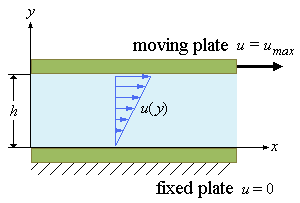| Viscosity and Flow Between Plates |
| symbol | description |
| u | velocity of fluid along the velocity profile |
| umax | velocity at the moving wall |
| h | distance between top and bottom plates |
| τ | shear stress |
| μ | viscosity |
| C | a constant |

| = |
| = C |
| u = | { |
|
| Therefore, C1 = 0 and C2 = |
|
| u( y) = |
| umax |
| = |
|
| τ = μ |
|